The correct way to drink a gin and tonic, according to experts
You may be missing a step

Your support helps us to tell the story
From reproductive rights to climate change to Big Tech, The Independent is on the ground when the story is developing. Whether it's investigating the financials of Elon Musk's pro-Trump PAC or producing our latest documentary, 'The A Word', which shines a light on the American women fighting for reproductive rights, we know how important it is to parse out the facts from the messaging.
At such a critical moment in US history, we need reporters on the ground. Your donation allows us to keep sending journalists to speak to both sides of the story.
The Independent is trusted by Americans across the entire political spectrum. And unlike many other quality news outlets, we choose not to lock Americans out of our reporting and analysis with paywalls. We believe quality journalism should be available to everyone, paid for by those who can afford it.
Your support makes all the difference.With just two ingredients, making and enjoying a gin and tonic should be a foolproof art - but there may be a step you are missing.
After blending the gin and tonic with ice, most drinkers then immediately begin to indulge in the refreshing cocktail - a common mistake, according to renowned gin expert David T Smith, who has teamed up with Gordon’s gin.
To get the most out of a gin and tonic, Smith told Good Housekeeping drinkers should actually wait a minute or two before sipping so the ice can melt.
While it may sound odd to let the ice melt and dilute the flavours, it is actually a method of blending the subtle notes of gin with the tonic - resulting in an all-around better drink, according to Smith.
“When the ice begins to melt; this not only makes the drink cooler but helps to marry all the flavours together,” the gin expert said.
However, whether this truly results in the perfect G&T is up for debate - as various cocktail recipes claim to produce the best version of the drink.
While experts have different recommendations - one thing they do agree on is a lot of ice.
Adam Ellesmere, “minister of fun” at Sipsmith, told The Independent: “Our first tip to create a beautifully balanced gin and tonic is ice, and plenty of it.
“The colder the drink, the less dilution and more flavour there is.”

Tony Conigliaro, drinks expert for Schweppes, agreed - telling us that the perfect gin and tonic begins with a glass full of freshly-frozen ice cubes.
As for whether you should actually let the ice melt before taking a sip, Adrian Smith, The Independent’s wine and spirits expert, said: “I have mixed feelings about this.
“When you add a little water to a high alcohol spirit such as whisky or gin, it will dilute the alcohol and can bring out the nuances (aromas and taste of the drink a lot more."
However, he isn’t convinced that a drink tasting better with ice is the result of it being diluted.
“To say a diluted gin and tonic would ‘marry’ the flavours together, in my mind, is a little extreme. I think it is common sense that when you add some ice to a drink it gets colder and typically tastes better," he said.
“I’m not so sure it’s the flavours marrying together as opposed to the fact it’s more refreshing because it’s cooler,” he continued, before comparing drinking an ice-cold Sprite to a lukewarm one and the obvious difference in enjoyment.
If you do try out the ice-melting technique, one thing to be aware of is letting the ice melt too much and ruining the drink.
“What you need to be extremely careful of is allowing the ice to melt too much and then destroying all traces of the botanicals in the gin,” Smith said. “At that point, there’s no going back and you may have just wasted your drink.”
As for the appropriate garnish, the answer is open for debate.
Although lemons or limes are typically used, a sprig of mint or a bit of ginger are both popular alternatives.
Join our commenting forum
Join thought-provoking conversations, follow other Independent readers and see their replies
Comments